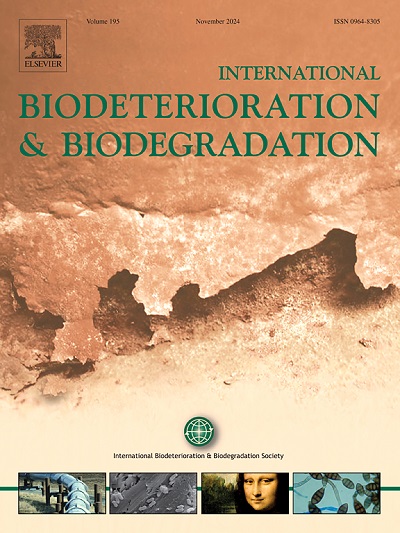MIL-88A(Fe) modified carriers induced iron autotrophic denitrification in intermittently-aerated MBBR for low C/N wastewater treatment
IF 4.1
2区 环境科学与生态学
Q2 BIOTECHNOLOGY & APPLIED MICROBIOLOGY
International Biodeterioration & Biodegradation
Pub Date : 2025-02-01
DOI:10.1016/j.ibiod.2025.106009
引用次数: 0
Abstract
Iron-assisted wastewater treatment has garnered significant attentions due to its promising potential for nitrogen removal under low carbon/nitrogen (C/N) ratios. However, the continuous addition of iron would result in unacceptably high operational cost. Herein, the iron mental-organic frame (MIL-88A(Fe)) modified sponge (MS) was developed as a source of continuous reactive iron sites and integrated in an intermittently-aerated moving bed biofilm reactor (MBBR) to enhance nitrogen removal efficiency under low (C/N) ratios. The results demonstrated that the MS-assisted system achieved stable total nitrogen removal of 76.2 ± 6.0% without adding additional iron and carbon sources when the C/N was 3.5 ± 0.3. After MS addition, the electron transport system activity increased from 8.2 ± 0.9 μgO2/g/h to 12.7 ± 2.6 μgO2/g/h, and the scanning electron microscope images revealed that the MS were covered with biofilm. Meanwhile, iron autotrophic bacteria (Thermomonas, Dechloromonas) and heterotrophic denitrifying bacteria (Candidatus_Competibacter) were enriched in the MS-assisted system, confirming the successful inducing of iron autotrophic denitrification process inside the reactor. This study revealed the effect of MS addition on microbial community succession and their pollutants removal characteristics, offering a feasible strategy for low C/N wastewater treatment.

MIL-88A(Fe)改性载体诱导间歇曝气MBBR处理低碳氮比废水的铁自养反硝化作用
铁辅助废水处理因其在低碳/氮(C/N)比下具有良好的脱氮潜力而受到广泛关注。然而,不断添加铁会导致难以接受的高运营成本。本研究开发了铁金属-有机框架(MIL-88A(Fe))改性海绵(MS)作为连续活性铁位点的来源,并将其集成到间歇曝气移动床生物膜反应器(MBBR)中,以提高低(C/N)比下的氮去除效率。结果表明,当C/N为3.5±0.3时,在不添加额外铁源和碳源的情况下,ms辅助体系的总氮去除率为76.2±6.0%。添加MS后,电子传递系统活性由8.2±0.9 μgO2/g/h提高到12.7±2.6 μgO2/g/h,扫描电镜图像显示MS被生物膜覆盖。同时,在ms辅助系统中富集了铁自养细菌(thermoonas, decchloromonas)和异养反硝化细菌(Candidatus_Competibacter),证实了反应器内铁自养反硝化过程的成功诱导。本研究揭示了添加MS对微生物群落演替及其污染物去除特性的影响,为低C/N废水处理提供了可行的策略。
本文章由计算机程序翻译,如有差异,请以英文原文为准。
求助全文
约1分钟内获得全文
求助全文
来源期刊
CiteScore
9.60
自引率
10.40%
发文量
107
审稿时长
21 days
期刊介绍:
International Biodeterioration and Biodegradation publishes original research papers and reviews on the biological causes of deterioration or degradation.

 求助内容:
求助内容: 应助结果提醒方式:
应助结果提醒方式:


